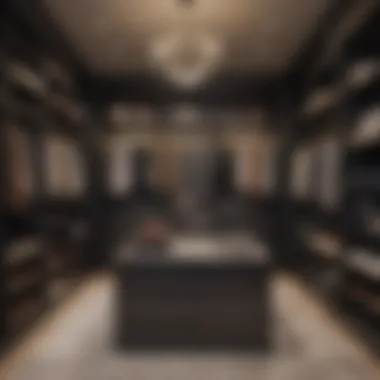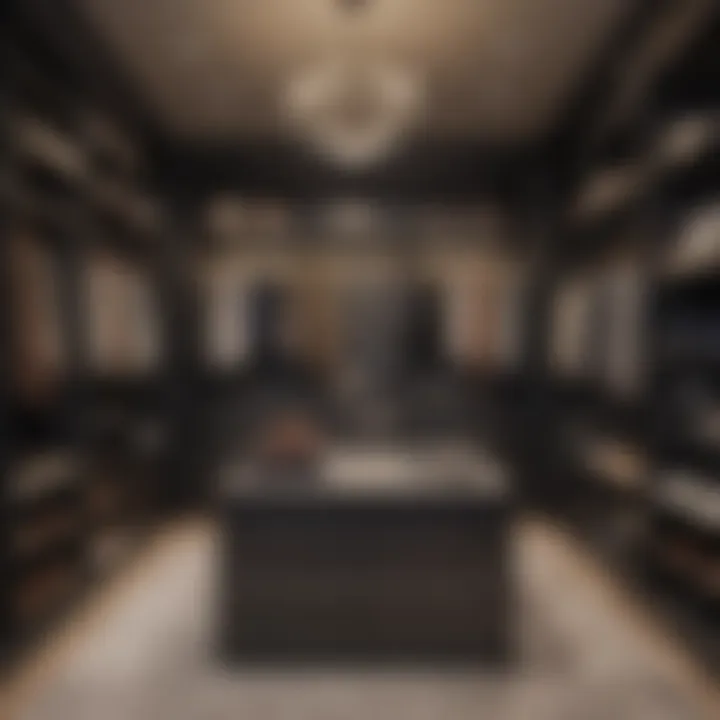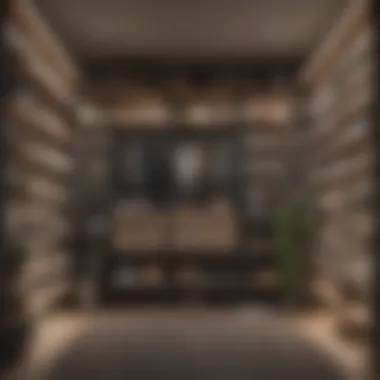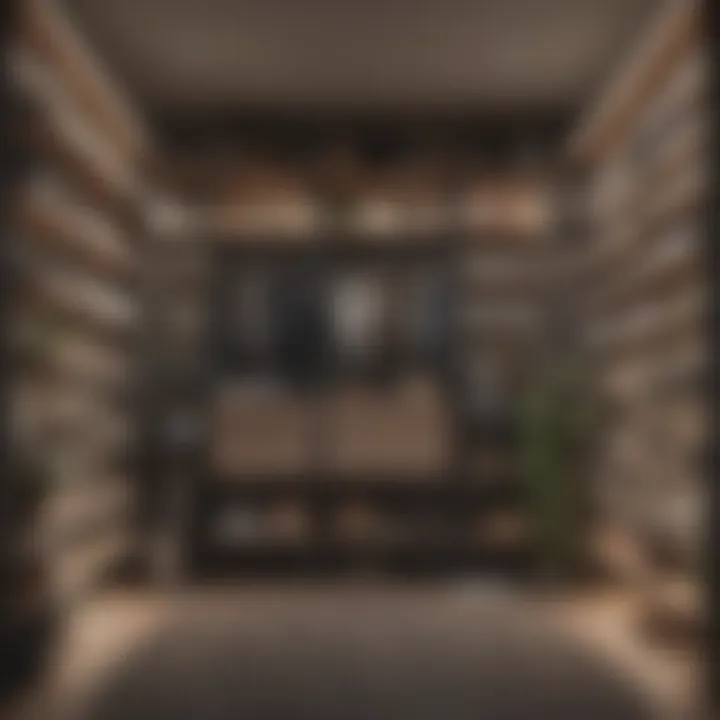Optimal Walk-in Closet Shelving Dimensions Explained


Intro
Choosing the right shelving involves understanding a variety of dimensions depending on your needs, styles, and what you tend to store. The quest to find the perfect fit can feel like a marathon at times, but through careful consideration, one can create an efficient storage solution that is both practical and aesthetically pleasing.
This article delves into the specifics of shelving dimensions, exploring both standard sizes and custom options, while also addressing factors like durability and ease of access. You'll find helpful insights ranging from clear measurement guidelines to essential tips that will aid in transforming your walk-in closet into a streamlined haven.
Key Insights and Trends
In recent times, the focus on home organization has surged, with more homeowners opting for personalized shelving solutions that reflect their individuality. Here are some key insights about what's trending in the world of walk-in closet design:
Current Trends in Interior Design
- Open Shelving: This has become increasingly popular as it merges aesthetics with practicality. Exposed shelves allow for easy visibility of items, encouraging regular use and simplifying selection.
- Multi-functional Units: Homeowners are leaning towards shelving that can adapt and serve multiple purposes, such as combining hanging spaces with shelving for bags or shoes.
- Sustainable Materials: People are also mindful of materials; bamboo and reclaimed wood are favored for their low environmental impact and unique character.
"The modern closet isn’t merely about storage; it's a microcosm of one’s personal style and organizational philosophy."
Popular Custom Solutions
- Adjustable Shelves: Flexibility in shelving height can optimize vertical space and accommodate varying sizes of clothing items, from long dresses to short jackets.
- Pull-out Drawers: These offer additional organizational options, making it easy to access smaller items without a hassle.
- Integrated Lighting: Having built-in light fixtures not only highlights your items but also adds a layer of sophistication.
Incorporating these insights can elevate your walk-in closet from a storage area to a stylish refuge.
Practical Tips and How-To Guides
When crafting your ideal closet, it is wise to have some practical tips in your back pocket. Here’s a step-by-step guide to optimizing your walk-in closet shelving:
- Measure Your Space Carefully: Always start by measuring the dimensions of your walk-in closet's length, width, and height. Don’t forget to consider the door swing and any built-in features.
- Evaluate Your Storage Needs: Take stock of what items you need to store. This will help inform the depth, height, and spacing of your shelves.
- Consider Shelf Depth: Generally, a depth of 12-16 inches works well for clothing, whereas shoes may require deeper shelves.
- Plan for Accessibility: Think about how often you’ll be reaching for specific items. Place daily use items at eye level and less frequently used items higher.
- Opt for Adjustable Solutions: Investing in adjustable shelving can save headaches and provide flexibility as your storage needs change over time.
- Add Personal Touches: Finally, don’t forget to make it your own with color, texture, and lighting that resonates with your aesthetic taste.
By applying these guidelines, you can deftly navigate the field of walk-in closet shelving dimensions, carving out a neat organizational framework tailored to your needs.
Preface to Walk-in Closets
Walk-in closets have become more than just storage spaces; they embody a sense of luxury and organization within a home. Turning a simple room into a walk-in closet allows homeowners to create a customized haven for their belongings. The success of this transformation is largely dependent on the thoughtful design and dimensions of shelving systems. Choosing the right shelving dimensions can prevent clutter and enhance the overall functionality of the closet.
When one thinks of a walk-in closet, the immediate features that come to mind include ample space and ease of access to clothing and accessories. However, there is more beneath the surface. A well-designed walk-in closet offers significant benefits: it can increase home value, enhance organization, and even promote a more streamlined daily routine.
- Efficiency: Choosing the correct dimensions ensures that each inch is utilized effectively.
- Aesthetics: Proper shelving not only functions well but should also please the eye, aligning with the homeowner's style.
- Accessibility: Having shelves at appropriate heights makes it easier for individuals of varying heights to reach their items without strain.
In this article, we will delve into the ins and outs of walk-in closets. We will explore critical elements such as the definition of a walk-in closet, the benefits of investing in one, and how these aspects relate to the overall organization of your space.
Understanding Shelving's Role
When it comes to walk-in closets, the shelving you choose makes a world of difference. The primary role of shelving isn't just to hold clothes and shoes; it’s about creating a structured environment where everything has its own place. A well-organized shelving system allows you to maximize space, keep items accessible, and maintain that ever-desired tidiness.
Good shelving caters to various types of belongings, from seasonal wear to everyday essentials, providing tailored storage solutions that cater to your lifestyle. It can even work wonders for small spaces, turning claustrophobic corners into functional areas.
Purpose of Shelving in Closets
The purpose of shelving in closets serves multiple facets. First and foremost, it acts as a support system for your belongings. Think of it like building a house; the shelves are the floorboards that keep everything steady and in place. Without the right shelving, your walk-in closet could quite easily become a chaotic storage pit.
Another significant purpose is visibility. Shelves elevate items off the ground, making everything easier to see and grab. No more rummaging through stacks of clothes that resemble Mount Everest. An organized shelf can reflect your personal style and lets you quickly identify what you have.
A systematized shelving layout can also help protect your items. Certain materials, like wood or wire, can prevent items from bending or becoming damaged, prolonging their lifespan. For example, a good quality wooden shelf will hold your shoes and bags without sagging over time.
To summarize, the functions of shelving can include:
- Support for various items
- Accessibility for quick retrieval
- Visibility allowing for easy organization
- Protection from damage
Types of Shelving Solutions
Diving into types of shelving solutions, you’ll find a buffet of options tailored to meet various needs. Each type has distinct advantages, so it’s essential to match them with your unique closet goals.


- Adjustable Shelving: This kind of shelving is great for flexibility. You can modify the height as your storage needs change.
- Fixed Shelving: If you have a clear idea of what you want to store, fixed shelves can create a stable, sturdy setup that maximizes vertical space.
- Corner Shelves: Perfect for utilizing those tricky corner spaces, corner shelves can add both style and functionality.
- Wire Shelving: Lightweight and often economical, wire shelving offers breathability, making it suitable for shoes and clothing to prevent humidity buildup.
- Built-in Shelving: For those looking to make a bold statement, built-in shelving can be customized to fit snugly into your closet design.
Each option has its unique strengths. Choosing the right type of shelving can give you a sense of order that impacts your entire closet experience. It's about selecting what best fits your personal storage narrative, ensuring you maintain an organized space that feels good to use.
The right shelving can make or break a walk-in closet's functionality. Be thoughtful in your choice.
Common Shelving Dimensions
Understanding the common shelving dimensions for walk-in closets isn't just about numbers; it's about creating a space that feels organized and efficient. The right dimensions can profoundly impact how well you utilize your closet space. After all, if the shelves are too deep or too short, you could end up with chaos instead of order. This section delves into the specifics of standard shelf depths, typical shelf heights, and width considerations, enriching your comprehension of what works best in your situation.
Standard Shelf Depths
When it comes to shelf depth, there's more to it than merely choosing a measurement that fits your items. Standard shelf depths typically range from 12 to 16 inches. This range works nicely for most items like sweaters, pants, or folded clothes. But here’s where it gets interesting: if you have a penchant for accessories or shoes, think about going a bit deeper. A shelf depth of 20 inches can be a game changer for storage of larger items.
Deep shelves provide ample space without the risk of items falling off. However, remember that more depth can also create a challenge when it comes to access. You wouldn’t want to struggle to reach that beloved winter coat stashed in the back.
- 12-16 inches: Typical for clothing items
- 18-20 inches: Ideal for larger items, such as purses or shoes
This balance between depth and accessibility can lend itself to a more functional closet, one where every item is easy to find and reach.
Typical Shelf Heights
An often overlooked component is shelf height. Typical heights vary based on the type of items you plan to store. Many homeowners find that spacing shelves 12 inches apart works well for folded clothes, while taller items like dresses may require 18 to 24 inches of height between shelves.
A good rule of thumb includes:
- 12 inches: For stacked sweaters
- 18-24 inches: For dresses or long coats
Ultimately, this comes down to your personal wardrobe. If you're the type who favors a few long pieces, making those shelf heights adjustable can allow for flexibility over time. It’s all about what suits your stylistic choices and needs.
Width Considerations for Shelves
Width is not simply a matter of aesthetics; it directly correlates with functionality. Standard widths for shelves tend to fall between 24 and 36 inches. Wider shelves can offer more space for grouping items together, and that can lead to a more organized feel.
However, too wide and the shelves might sag or feel unstable, especially if they’re made of composite materials. A good size range can include:
- 24 inches: Perfect for smaller closets or tight spaces
- 30-36 inches: Works well for open shelving setups or larger items
The final consideration here should also be the support of the shelving. Thicker boards can handle more weight and wider spans. Ensure that you account for what and how much will be stored on these shelves, balancing the width for maximum strength and utility.
Remember, balance is key - between aesthetics and functionality, between having space and accessibility.
By being mindful of these common shelving dimensions, you pave the way for a walk-in closet that is as efficient as it is stylish, meeting your needs without sacrificing organization or flair.
Customizing Shelf Dimensions
Customizing walk-in closet shelving dimensions is crucial for optimizing space and ensuring that the different items are stored efficiently. It isn’t just about tossing in some boards; it’s about creating a sanctuary where everything has its place. When you tailor the dimensions to your specific needs, you elevate functionality, improve accessibility, and make the best use of every nook and cranny available.
There are several layers to consider when customizing dimensions. First and foremost, it’s essential to identify what items you’ll put on the shelves. Will these be small shoes, large boxes, hanging clothes, or perhaps even bins of gardening supplies? Knowing this can help you sketch out dimensions that truly meet your storage needs.
Factors Influencing Custom Dimensions
When it comes to the nitty-gritty of customizing shelf dimensions, various factors come into play. Let’s break them down a bit:
- Item Size: The actual size of the items you plan to store is often the most significant influence. Smaller items might only need a shelf depth of around 12 inches, while larger items can require deeper shelves.
- Height Variability: Your height matters. If you’re on the shorter side, placing shelves too high can create challenges for accessibility. Conversely, tall folks might find standard heights insufficient.
- Intended Use: Are you using this closet strictly for storage or also as a dressing area? This distinction can shape your decisions.
- Flexibility Needs: Maybe you have a habit of changing things up now and then. Adjustable shelving can be a game changer here. You may want to leave some space for future adjustments.
"Customizing dimensions means turning that closet from just a box into a well-oiled organization machine, fit for Kings and Queens of clutter."
Materials and Their Impact on Dimensions
It’s not all about wood versus metal; the types of materials you choose have a significant effect on the effective use of dimensions in your shelving plans. The weight of the material dictates how much width and depth you might need. For instance:


- Wood: Solid wood shelves tend to be bulkier due to their weight. But with proper installation, they can provide sturdiness and longevity.
- Particle Board: This material is lighter, which can simplify assembly but may not support as much weight. It often requires thicker shelves to hold up effectively.
- Metal: If you're looking for a sleek aesthetic, metal can do wonders. Plus, it often allows for thinner shelving while maintaining strength, allowing for a streamlined look.
These materials intersect with your customized dimensions to ensure that what you use not only fits but stands the test of time. Always remember: the right material coupled with the right dimensions ensures that your closet doesn’t just hold your items, but organizes them beautifully!
Maximizing Storage Efficiency
Maximizing storage efficiency in walk-in closets isn't just about cramming in the most items possible. It's about strategically planning how to utilize each square inch of space while keeping your belongings organized and easily accessible. In a world where we accumulate more stuff than we often know what to do with, effective shelving becomes the unsung hero of closet design. By taking the time to consider how high or low your shelves should be, we can transform a cluttered space into a sanctuary of order.
Vertical vs Horizontal Shelving
When it comes to shelving layouts, vertical and horizontal configurations offer distinct advantages. Vertical shelving is a favorite in many walk-in closets because it draws the eye upward, making the room feel more spacious. Imagine a shelf climbing the entire height of the wall, allowing ample room for storage while keeping floor space clear. This arrangement maximizes storage without sacrificing aesthetics. Furthermore, vertical shelves can accommodate larger boxes or bins that are ideal for items not used daily, such as seasonal wear.
Conversely, horizontal shelving works well for frequently accessed items. It allows for easy visibility and quick retrieval while minimizing the possibility of digging through a pile of clothes or clutter. When you place shoes on a horizontal shelf, for instance, you can see all of them at a glance, reducing the time spent searching for the perfect pair.
Here’s a breakdown of when to choose each:
- Vertical Shelving
- Horizontal Shelving
- Best for limited floor space
- Creates a feeling of grandeur
- Great for seasonal or rarely used items
- Ideal for everyday essentials
- Facilitates easy access and organization
- Allows for a clean and neat look
It's important to evaluate what your priorities are when designing shelving to ensure a mix that serves various needs.
Configuring Shelves for Accessibility
Configuring your shelves for accessibility is crucial when it comes to maximizing efficiency. Think about how often you retrieve items from these shelves. If you're like most homeowners, you're probably not standing on a ladder every time you want to grab that handbag you wear once a season. It’s pivotal to place the items you use often at eye level or within easy reach while reserving higher shelves for less used items.
One helpful approachists often employ is the principle of the “five-second rule.” If you can’t grab, see, or use an item within five seconds, you might want to reconsider its placement. This hands-on approach allows you to tailor your design to your specific habits. Here are some key pointers to keep in mind:
- Use Narrow Shelving for Small Items
Organize accessories or shoes in narrow spaces that fit snugly in corners. - Layering
Install adjustable shelving. Having the flexibility to change the height based on your needs means everything can have a home – even the items that might fluctuate seasonally. - Labels
Simple but effective. Adequate labeling ensures you can always find what’s tucked away.
Importantly, keeping your shelves uncluttered goes a long way too. Too many items can block visibility and diminish accessibility.
In summary, an efficient shelving system combines functionality with accessibility, ensuring that each item has a designated space while remaining easy to reach.
In delivering a conscious and dynamic approach to your walk-in closet shelving, you open the door to a world of organized living. You deserve a space that not only reflects your style but also effortlessly caters to your daily life.
Integration with Closet Design
When it comes to planning a walk-in closet, the importance of integrating shelving seamlessly into the overall design cannot be underestimated. It's not merely about tossing in some boards and calling it a day. The shelving plays a pivotal role, harmonizing with other elements like hanging rods, shoe racks, and even drawer units. This coordination goes a long way toward maximizing both function and aesthetic appeal. The right shelving can make a cramped closet feel open and free-flowing, while poor choices can create clutter and chaos.
Coordinating with Other Closet Features
The coordination of shelving with other closet features requires a thoughtful approach. Imagine the frustration when a shelf's depth clashes with the length of a hanging rod or when a too-high shelf renders a fabulous pair of shoes out of reach. To avoid these mishaps, here are some pointers:
- Uniform Depth and Height: Aim for consistent dimensions across various storage components. For example, if the shelving is 14 inches deep, having hanging rods extend out the same distance creates a cohesive look.
- Flow of Functionality: Organize items based on their frequency of use. Frequently accessed items should be at eye level or even lower. Placing your favorite handbags or everyday shoes at the top may leave you in a bind.
- Accessibility: Ensure other features like drawers and rotational racks are easy to navigate in conjunction with the shelves.
By considering how each element interacts with the others, you can make the most of your space, transforming it into a well-oiled organizational machine.
Aesthetics: Matching Style and Dimensions
A beautiful design isn’t just about choosing the right materials; it's about ensuring everything feels right together. This balance can elevate a closet from a storage area to a statement piece in your home. Matching styles among shelving and other elements lends a laid-back elegance to the space. Here are a few ways to consider aesthetics:
- Materials Matter: Whether you lean toward sleek metal or natural wood, make sure the material of your shelves complements not just the closet's purpose but also its overall design language. A rustic wooden shelf might clash against gleaming metal rods, creating visual dissonance.
- Color Palette: Be mindful of colors. Light hues can give a more spacious feel, while darker tones can add warmth and coziness. Mixing colors can be refreshing, but moderation is key.
- Design Features: Architectural details, like crown molding or baseboards, should be taken into account. They can either enhance or detract from your shelving choices. A carefully chosen shelf can highlight these design features or seamlessly blend in to let them shine.
Incorporating a thoughtful approach to style and dimensions not only enhances functionality but also transforms the closet into a stylish haven, that reflects personal taste and enhances one's daily life.
"A well-designed closet is a harmony of storage solutions; integrating dimensions, materials, and features is key to achieving a space that's not just functional but also a reflection of who you are."
Taking the time to integrate shelving with conscious planning leads to a space where every piece complements the next, forming a beautiful symphony of organization and style.


User-Centric Design Considerations
When delving into the realm of walk-in closet design, one must prioritize the needs of the end-user. This concept, known as user-centric design, focuses on creating a closet space that aligns with individual habits and preferences, reflecting the unique lifestyle of the homeowner. Customization is key, and it can make all the difference in how effectively a closet serves its purpose. By taking into account who will use the closet and how they will use it, you can craft an organized space tailored to personal demands.
User Height and Reach Considerations
The height of shelving is not just about aesthetics—it's fundamentally about accessibility. Shelves positioned too high can become a frustrating barrier, while those too low can lead to unnecessary bending or stooping. Hence, understanding the height of the primary users is essential. Consider conducting a simple experiment; have each user stand next to a wall or a piece of furniture to measure their reach comfortably. This will inform the optimal shelf height.
For example:
- Shorter Individuals: Those under 5’4” might find shelves at 60 to 66 inches aligned with their needs, permitting them to reach everyday items with ease.
- Average Heights: Individuals around 5’5” to 6’1” will benefit from shelving placed between 66 to 72 inches, maximizing storage yet remaining within reach.
- Tall Users: If a user stands above 6’1”, shelves can be set higher, perhaps even up to 78 inches. However, it's advisable to include some lower shelves for commonly used items.
It's not just height either; ensuring a balance between upper and lower shelving can allow items to be reached easily without a step stool or ladder, improving the efficiency of the closet overall.
Adapting Shelves for Different Users
Not every user will have the same requirements or preferences when it comes to their closets, making adaptability a hallmark of thoughtful shelving design. This aspect ties back to consulting with users during the planning phase.
Consider these strategies for adaptability:
- Adjustable Shelf Systems: Using brackets that allow shelves to be moved up or down can cater to various users. Professionals often recommend the use of systems that let you modify shelving height according to storage needs.
- Diverse Shelf Sizes: Incorporating a mix of shelf widths and depths can accommodate a range of items from shoes to bags to larger seasonal clothing. For instance, deeper shelves may be excellent for bulky items, while shallower ones may be ideal for shoes or accessories.
- Personalized Zones: Create dedicated zones for different users or categories of items. For example, if siblings share a closet, separate sections with varying access heights can prevent clutter and facilitate organized storage.
"In designing a space, understanding user dynamics can lead to functional beauty."
By prioritizing user-centric design in the walk-in closet, one can not only enhance the functionality of the space but also create an environment that feels uniquely customized and personalized. This deep understanding ensures the closet meets the physical needs and lifestyle of its users, promoting efficient sotrage and ease of use.
Maintaining Shelving Systems
Maintaining a well-organized shelving system is crucial for the longevity and functionality of your walk-in closet. After all, these shelves do not just serve as a hiding place for your shoes and clothes; they're essential components that blend style with utility. Regular upkeep ensures that you can access your belongings without hindrance, while also keeping the aesthetics of your space intact. When neglected, poor maintenance can lead to unsightly damage and decreased lifespan of your shelving solutions.
Cleaning and Maintenance of Shelves
Keeping your shelves clean is not just about appearance; it's also key to their functionality. Dust and grime can accumulate—particularly in deep or high shelves—making it challenging to find your belongings. Regular cleaning can also prolong the life of the materials. Here are some practical steps for maintaining cleanliness:
- Dust Regularly: Use a soft cloth or a microfiber duster. For hard-to-reach shelves, an extendable duster can make the job easier.
- Use Mild Cleaners: Avoid harsh chemicals which might strip away protective finishes or damage certain materials. A simple mix of warm water and soap usually does the trick.
- Check for Moisture: If your closet shares space with a bathroom or laundry room, monitor for dampness, as this can promote mold and decay.
- Inspect Structural Integrity: While cleaning, look closely at the brackets and supports for any signs of wear and tear, which could be a telltale sign that adjustments are needed.
Adopting a cleaning routine is simple—setting aside a weekend afternoon once a month can make a world of difference.
Longevity of Shelving Materials
Choosing the right materials for your shelves sets the stage for a longer lifespan, but regular maintenance will ultimately determine their durability. Think about factors like:
- Material Type: Wood, laminate, metal, or glass each come with their own set of maintenance steps. Wood may need periodic polishing, while metal might require less upkeep but should be checked for rust.
- Weight Capacity: Overloading shelves is a surefire way to reduce their lifespan. Always adhere to weight recommendations, which are usually provided by the manufacturer.
- Sunlight Exposure: If your closet receives a lot of direct sunlight, the materials may fade or warp. Consider using curtains or blinds to block out excessive light, protecting your shelving from potential damage.
- Humidity Levels: Excessive humidity can warp wooden shelves or promote mildew. Utilizing a dehumidifier can help maintain a balanced environment.
"An ounce of prevention is worth a pound of cure." This old saying holds true when it comes to shelving systems. Taking a little time now can save headaches down the line.
Ultimately, a little vigilance goes a long way in maintenance. By focusing on cleaning and understanding the implications of material choices, you can maintain a beautiful and functional shelving system that meets your organizational needs. Regular investment in upkeep ensures that your walk-in closet remains not just a storage space but a reflection of your style and practicality.
Finale: Choosing the Right Dimensions
Selecting the right dimensions for your walk-in closet shelving is more than just a matter of aesthetics—it’s about creating an effective and functional space that meets your personal needs. Dimensions dictate the usability of your shelves, influencing how much can be stored and how accessible those items are at any given moment. Just imagine reaching for a crucial outfit only to find it buried under an avalanche of unrelated items. Frustrating, isn’t it? A well-planned shelving system can significantly reduce such mishaps.
In this article, we’ve discussed various dimensions, including standard shelf depths, heights, and widths. Each has a specific role in enhancing the efficiency of your closet. When you understand these key measurements, you can tailor your shelving solutions to your unique requirements—be those considerations the types of items you store, the amount of space available, or personal comfort in accessing those items.
Recap of Key Dimensions
- Standard Shelf Depths: Most shelving ranges between 12 and 16 inches deep. This is often sufficient for storing various items without taking over the whole closet.
- Typical Shelf Heights: Ideal heights vary according to user reach—common ranges are from 12 inches to 60 inches, designed to accommodate shoes, clothing, and accessories appropriately.
- Width Considerations for Shelves: While larger shelves sound appealing, they can bend or collapse under excessive weight. Keeping widths around 36 to 48 inches ensures stability and ease of use.
These recap points are essential as they lay the groundwork for crafting a system that’s as efficient as it is pleasing to the eye.
Final Thoughts on Customization and Design
Customization stands as a fundamental aspect of creating the ideal shelving system. It’s a chance to tailor dimensions that reflect your lifestyle. Think about it: a busy professional might prioritize quick access to their work attire, while a fashion enthusiast may prefer detailed organization stratagems for their designer shoes.
Benefits of Customization:
- Personalized Fit: Optimizing dimensions based on the items you store.
- Aesthetic Alignment: Coordinating styles and materials to match the overall design of your home.
- Improved Accessibility: Designing shelves so you can easily reach what you need without hassle.
Just remember, there’s no one-size-fits-all solution when it comes to walk-in closet shelving. Finding the right dimensions involves a mix of personal preferences, practicality, and the overall design you wish to achieve.



